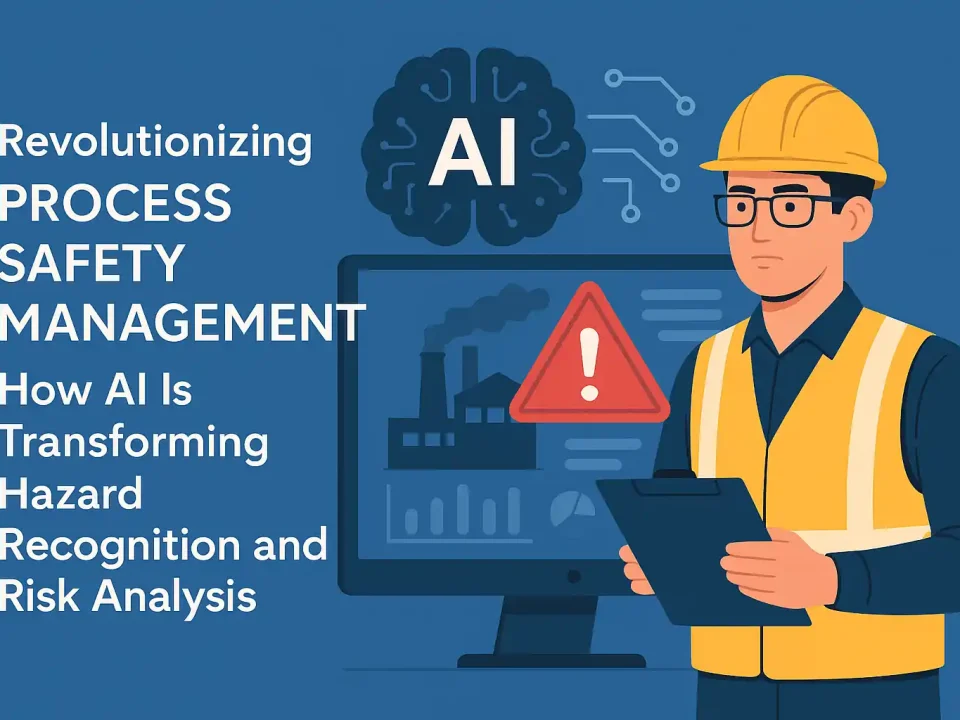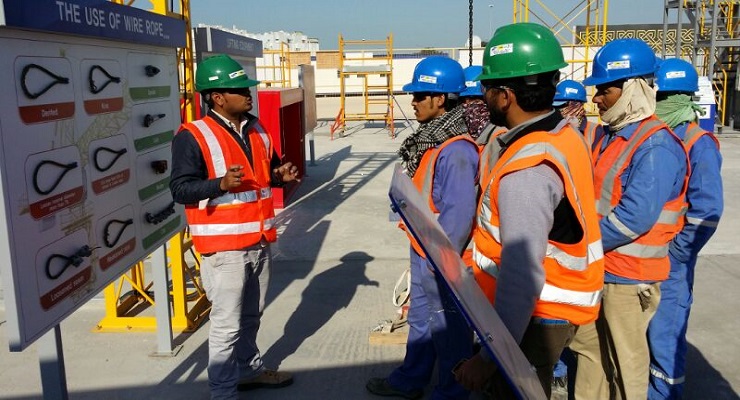The Digital Tipping Point: How AI, Digital Twins & Predictive Analytics Are Reshaping Process Safety in 2025

Electrical Hazards and Safety: Types, Dangers, and Examples
September 26, 2025
Comprehensive Guide to Fire Risk Assessment – Ensuring Safety
October 10, 2025The landscape of process safety is undergoing a fundamental transformation. Traditional safety approaches—while still vital—are increasingly augmented by digital technologies that allow organizations to predict, prevent, and respond to hazards more effectively than ever before. In 2025, tools like Artificial Intelligence (AI), Digital Twins, and Predictive Analytics are redefining how industries manage risk, enhance operational efficiency, and protect both personnel and assets. This digital tipping point marks a new era where process safety is proactive, data-driven, and continuously optimized.
Understanding the Digital Transformation in Process Safety
Process safety has historically relied on structured methodologies such as HAZOP studies, risk assessments, and incident investigations. These tools are invaluable for identifying hazards and implementing safeguards. However, the dynamic and complex nature of modern industrial operations demands faster, more precise, and predictive safety strategies. This is where digital technologies step in.
AI provides the computational power to analyze vast amounts of process and operational data, identifying patterns that may signal emerging hazards. Digital Twins—virtual replicas of physical assets or systems—allow operators to simulate scenarios, test modifications, and predict outcomes without impacting real-world operations. Predictive Analytics combines historical and real-time data to forecast potential failures, enabling proactive maintenance and risk mitigation.
Together, these tools elevate process safety from reactive problem-solving to anticipatory, data-driven management.
AI in Process Safety: From Insight to Action
Artificial Intelligence is increasingly at the forefront of process safety transformation. By leveraging machine learning algorithms and advanced analytics, AI can identify subtle trends in operational data that might escape human observation. For example:
- Anomaly Detection: AI algorithms can continuously monitor sensor data to detect deviations from normal operating conditions, signaling potential equipment malfunctions or unsafe process conditions.
- Root Cause Analysis: Post-incident, AI can rapidly analyze historical data to identify contributing factors, accelerating corrective actions and preventing recurrence.
- Decision Support: AI-powered dashboards can provide real-time recommendations for operators, highlighting immediate interventions to reduce risks.
Integrating AI into safety management not only enhances hazard detection but also complements traditional methods. For instance, insights derived from AI can guide Behavior-Based Safety Training programs, helping employees recognize patterns that lead to unsafe conditions and adjust their behavior accordingly.
Digital Twins: Simulating Safety Scenarios
A Digital Twin is a dynamic, virtual representation of a physical asset or system, continuously updated with real-time data. In process safety, Digital Twins allow organizations to:
- Test Safety Protocols: Simulate operational scenarios, including emergency situations, to evaluate the effectiveness of safety systems.
- Predict Failures: Identify potential failure points in equipment or processes before they occur.
- Optimize Processes: Adjust operational parameters in the digital environment to enhance safety and efficiency without affecting live operations.
For example, a chemical plant can use a Digital Twin of its reactors to model potential overpressure scenarios and validate mitigation strategies. This enables proactive interventions that reduce the likelihood of incidents in the physical plant.
Predictive Analytics: Anticipating Hazards
Predictive Analytics leverages historical and real-time data to forecast potential risks. By combining process data, maintenance records, and environmental factors, predictive models can anticipate failures and hazardous events. Applications include:
- Equipment Maintenance: Predictive models identify when machinery is likely to fail, allowing preemptive maintenance and reducing the risk of accidents.
- Process Deviations: Forecast deviations in critical process parameters, enabling timely corrective actions.
- Resource Allocation: Focus safety resources on high-risk areas, enhancing efficiency and risk reduction.
By integrating Predictive Analytics into a comprehensive Safety Management System, organizations move from reactive incident response to proactive risk prevention, creating a safer and more resilient operational environment.
Synergy with Traditional Safety Practices
While digital technologies are transformative, their value is maximized when integrated with established safety practices:
HAZOP Integration
HAZOP studies remain essential for systematically identifying hazards and deviations. Digital tools can enhance HAZOP effectiveness by:
- Automating data collection and analysis, reducing the time required for studies.
- Using AI to prioritize risks based on real-time process data.
- Simulating recommended interventions in Digital Twins before implementation.
Investing in HAZOP Training ensures that personnel are equipped to interpret both traditional and digital insights, bridging the gap between analysis and actionable safety improvements.
Safety Audits and Compliance
Digital monitoring complements regular Safety Audit Service evaluations. Real-time data dashboards allow auditors to track compliance with safety protocols continuously. For instance, deviations flagged by predictive models can be reviewed and addressed during audits, creating a closed-loop system that reinforces safety standards. Additionally, combining predictive insights with routine Fire Safety Audit activities ensures that both process-specific and general safety measures are aligned and optimized.
Behavior-Based Safety
AI and analytics provide actionable insights into human behavior, highlighting patterns that may contribute to unsafe practices. Integrating these insights into behavior-based programs ensures employees are trained to recognize and correct risky behaviors before they lead to incidents.
Real-World Applications of the Digital Tipping Point
- Oil & Gas Industry: AI-driven monitoring of pipelines detects subtle pressure variations, enabling early intervention to prevent leaks or explosions. Digital Twins allow operators to simulate emergency shutdown procedures, ensuring effective response strategies.
- Chemical Manufacturing: Predictive analytics forecast equipment wear and process deviations, reducing downtime and minimizing exposure to hazardous chemicals.
- Pharmaceuticals: Digital Twins optimize process safety in complex production environments, ensuring compliance with stringent regulatory standards while maintaining operational efficiency.
These examples demonstrate that digital technologies are not just theoretical enhancements—they provide measurable improvements in safety outcomes, operational efficiency, and compliance.
Challenges and Considerations
Despite the promise of AI, Digital Twins, and Predictive Analytics, organizations must navigate several challenges:
- Data Quality: Accurate predictions depend on high-quality, reliable data from sensors and systems.
- Integration Complexity: Combining digital insights with traditional SMS structures requires careful planning and coordination across departments.
- Skill Requirements: Employees must be trained not only in traditional safety practices but also in interpreting and acting upon digital insights.
- Cybersecurity: Digital systems introduce new vulnerabilities that must be managed to ensure operational safety and data integrity.
Addressing these challenges requires a strategic approach, including continuous Behavior-Based Safety Training, investment in IT infrastructure, and cross-functional collaboration between safety, operations, and engineering teams.
The Road Ahead: Continuous Improvement
The convergence of AI, Digital Twins, and Predictive Analytics signals a new era in process safety, where organizations can anticipate and mitigate risks with unprecedented precision. Key steps for leveraging this digital tipping point include:
- Digital Readiness Assessment: Evaluate existing systems, data quality, and workforce capabilities.
- Integration Planning: Align digital tools with existing Safety Management Systems, audits, and training programs.
- Pilot Projects: Start with focused implementations, such as predictive maintenance for high-risk equipment.
- Scale and Optimize: Expand digital adoption across operations while continuously monitoring effectiveness and refining processes.
In this context, engaging with professional Safety Audit Service providers ensures that both traditional and digital safety measures are fully aligned and continuously optimized.
Conclusion: Embracing the Digital Tipping Point
In 2025, process safety is no longer just about compliance or reactive interventions. It is about leveraging the synergy between traditional safety practices and cutting-edge digital technologies. AI, Digital Twins, and Predictive Analytics empower organizations to anticipate hazards, optimize operations, and cultivate a culture of proactive safety.
By integrating these technologies with established practices such as HAZOP studies, behavior-based training, and comprehensive Fire Safety Audit protocols, companies can transform safety management from a compliance obligation into a strategic advantage. This digital tipping point ensures that safety is dynamic, intelligent, and resilient—creating safer workplaces, protecting assets, and safeguarding lives.
For organizations ready to embrace this transformation, the journey begins with integrating digital insights into everyday safety practices, training teams to act on predictive intelligence, and continuously auditing performance to ensure sustainable improvements. The future of process safety is here, and it is digital, proactive, and data-driven.




